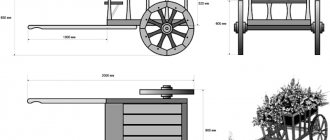Flowers won't decorate your garden all year round, but there is a way to add some color to your landscape with unusual, colorful garden decor. For example, make round mosaic tiles with your own hands.
Thrifty owners always know how to give a second life to old items. For example, do not rush to throw away broken pieces of a ceramic mug. With their help, you can make wonderful elements of garden decor - mosaic panels that will make the garden sparkle with new colors. We tell you how to do this.
What will you need?
- Concrete blanks (in our case, a circle) or clay pots are suitable as a base - this material serves as a good base for mosaics.
- You will also need broken porcelain, glass shards, stones, crystals, large beads or anything else that you have on hand that is suitable for creating a mosaic surface.
- You can't do it without imagination. Everything regarding materials, sizes and shapes of decorative elements depends only on you. We will show you how to implement just one of the ideas. This can become the basis for creating a great variety of original and, very importantly, unique items.
Tabletop
In the same simple way, you can lay out a mosaic on the tabletop, and when developing a sketch, ready-made templates on self-adhesive paper will help you. Upon completion of the work, you can rub the composition with wax for greater shine. In practice, the uneven, rough surface of the table is not always convenient, so the mosaic is often covered with thick glass . The glass “cap” will also hide any unevenness when using a mosaic of sea pebbles or CDs.
Chic table with handmade mosaic
This wrought iron table is suitable for the home, garden, and balcony
Small garden table with turquoise tiles
Glue selection
It is advisable to manipulate the transparent adhesive or white ceramic mixture, diluting it according to the instructions, thus ensuring clarity of the composition. To apply the solution, you need a spatula that promises evenness and smoothness to the layer.
You can lay out a drawing in an orderly manner by transferring the image and its filling, or in a chaotic manner, when the fragments are placed in random order.
- The latest version is often taken up by novice creators.
- For colorfulness, multi-colored “puzzles” are used, differing in size and format.
- The adhesive base under each piece may differ in thickness to level the panel in height.
- Under a thick paving slab it will be smaller, and under a thin wall slab it will be larger.
- They lubricate not only the coating, but also the fractions themselves, gradually moving forward, covering small areas.
Cement glue is suitable for concrete; for installation on wood, you can use liquid nails. Floor variations must be smooth; roughness and imperfections will make walking uncomfortable.
The evenness of the coating is achieved by applying a wood or plastic sheet. External installations can be mounted on cement.
Drawing a sketch
A sketch is an image of an object as it will look when finished. The sketch of the mosaic panel must be done in color. This will help you navigate when putting together a set and makes it possible to assess in advance how the colors will look in the interior. It is most convenient to draw a sketch in full size, as it will be clearer where small elements are needed.
For a geometric pattern, the sketch can be drawn up in the form of a knitting or cross stitch pattern. Using this scheme, it is convenient to count the number of small pixel squares, from which mosaics are most often made.
Advantages and disadvantages
Mosaic paintings stand out:
- Long service life;
- Practicality;
- Economical;
- The ability to translate any ideas into reality;
- Harmonious compatibility with the surroundings.
Disadvantages include the complexity of the technology in compliance with all recommendations and the manufacturing time.
Such creativity can be compared to painting; sometimes fantastic sketches are created from unclaimed waste, which become a source of pride for the owners and the highlight of the surrounding space.
Preparation of pieces
If there are broken residues, the issue resolves itself. Whole damaged tiles are cut into the required segments; a tile cutter is used for these purposes; if the chosen tool is a hammer, then it is used after wrapping the samples in a rag, preventing the fragments from scattering to the sides.
Do not overdo it with the power of blows, so as not to end up with crumbs. It is better to start selecting material in advance, gradually collecting it in sufficient quantities. Single-color combat is good on garden paths.
Mosaic on the wall
When laying mosaics on the wall (in the bathroom , in the kitchen as a work belt, for panels, in a children's bedroom , etc.) there are some characteristic nuances. Often, mosaic is applied to the surface as a finishing piece, that is, when decorating the wall together with paint , plaster or tiles.
Large-scale mosaic on the kitchen wall in Art Nouveau style. The process of laying it is labor-intensive, rather “dirty” and is accessible mainly to specialists. But you can learn on your own
Column stylishly decorated with a scattering of marble, polished copper and neon pieces
To simplify the process, you can use mesh sheets (in the form of squares or rectangles) of bonded mosaics, these are sold in hardware stores with a ready-made pattern. The sheets are assembled like puzzles, and according to the technology they are laid like ordinary tiles. The question of price can be confusing. It's not cheap.
An interesting combination of glass mosaic and wood in the decor of a fireplace
Cow skull with mirror mosaic and decor - a bold, rebellious home decoration
Mosaic is an extremely labor-intensive art form. But if you are drawn to it, you can even try your hand at large-scale works. The main thing is to be confident in your own sense of style
In large construction stores you can purchase ready-made portraits of celebrities
Installation specifics
Pre-prepare the surface. The base is represented by cement-sand screed, plaster, plasterboard, putty. The old finish is removed from the walls, then the cracks are carefully sealed and irregularities are eliminated.
Be sure to apply a primer to promote adhesion. You should not place elements without gaps; gaps are required to compensate for thermal expansion from temperature changes.
However, you won’t decorate the work with huge spaces either, which can be round, square, or triangular in configuration.
- Approach fragmentary dimensions wisely; identical segments look banal, but pieces that differ too much in size do not guarantee beauty.
- Polishing gives the effect of newness and shine, but it is better not to subject the floor to this procedure to prevent slipping.
- The piece will take about a day to dry. Then the seams are treated with light grout, applying the mixture with a rubber spatula into the voids.
After 30 minutes, the creation is wiped with a dampened cloth to remove the excess grout layer; the remaining stains are removed with a special product.
Create a unique pattern
The development of an ornament is a creative process that does not obey any standards. You can make a mosaic of any design that the master likes. If the image is small, you can enlarge it using a projector or manually. For the last method, you need to divide the original drawing into squares, then make a grid of enlarged fragments and redraw the contents of each square enlarged to the required size.
If a person has artistic skills, then he will be able to draw any pattern or picture for a panel on his own. The picture can also be enlarged and printed using computer technology.
Create a garden patio with mosaic tiles
A patio is an open area that does not have a roof and is used for communal recreation. If the garden area allows, then such an element will fit perfectly into it. Moreover, during the holiday, guests and all family members will not only relax, but also enjoy nature.
In dry weather, you can have tea parties, picnics, and barbecues on the patio. Garden furniture located in this area will allow you to read a book in nature, listen to music, sunbathe or simply enjoy being in the fresh air.
To build a patio in the garden, you must first prepare a site for it. Get rid of all vegetation and level the surface. We suggest considering the option of constructing a patio, which consists of individual cement slabs covered with mosaics.
Choose the shape of the slabs yourself, depending on your preferences and the shape of the patio area itself.
To make a patio in the garden, you need:
- cement mortar;
- shovels;
- buckets;
- gloves;
- several cardboard strips;
- spatula;
- rubber hammer;
- small stones that will fill the space between the slabs.
The optimal temperature for work is from +15 to +20. At a lower temperature, the cement will harden for a very long time, but at a higher temperature, on the contrary, it will harden quickly and the shape of the mosaic will be very difficult to correct.
Pre-treat the patio area with special products that will destroy all vegetation. Draw a sketch of the future patio and develop the shape of the mosaic. It is recommended to create medium-sized slabs, since too large ones will crack, and too small ones will require time-consuming work to lay the mosaic.
The optimal size for a slab is one and a half feet. When the vegetation is destroyed, using lime or paint, the location of the slabs should be marked on the surface. You first need to moisten the soil, as it will dig. A small groove should be made around the outline of each tile, into which cardboard formwork is installed. It is better to do each tile separately in turn. Fix the cardboard well in the ground so that the cement mortar does not leak through it during the pouring process.
Prepare the mortar, cement and sand, three to one, and pour in enough water to get a thick but elastic mass. Make a solution for one slab and fill it, repeat the process with all slabs. Level the surface and get rid of excess air, as it will lead to cracking in the future. When all the slabs are poured, prepare the mosaic. Any pieces of natural stone, tile or glass are suitable for it. Dip the bottom part of the mosaic into the solution and install it in the space between the slabs. After 24 hours, the cardboard formwork must be removed and the sharp ends of the tiles must be cleaned. After another 24 hours, take a brush and clean the mosaic. The patio will be operational two weeks after this work is completed, since it takes time for the cement to strengthen and set well.
Tip: Use colored gravel to fill the space between the tiles. The bottoms of multi-colored glass bottles, in which LEDs are pre-installed, also perfectly decorate the slabs, and at night the patio turns into a place to relax with illumination, beckons with magic and enchants vacationers.
What stones can be used?
A material often used by garden mosaic lovers is river pebbles. But impressive pictures can also be made from other stones:
- granite fragments,
- limestone,
- sandstone,
- basalt,
- travertine,
- quartz.
It is easy to experiment with their arrangement in the mosaic, creating fancy patterns.
Decor of furniture elements with mosaics
Using modern adhesives and solutions, mosaics can be used to cover various surfaces, from concrete or wood to metal. Using mosaics, you can decorate the apron above the working area of the summer kitchen, the surface of the dining table, chairs, as well as various benches and armchairs. More garden bench ideas.
Garden stained glass
Separately, you can consider this method of decoration as garden stained glass. It is also a variant of mosaic. It is rarely used in outdoor decorations, considering glass to be impractical and fragile.
But you take the risk of using stained glass patterns in the decor of your garden, and you will see how colored glass, playing in the sun, will enliven your decor.
You can decorate with stained glass arbors, screens and pergolas, metal forged railings and fences, garden lamps and various decorative elements.











